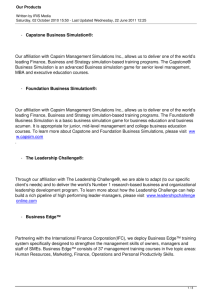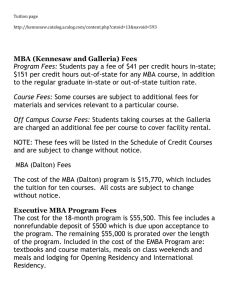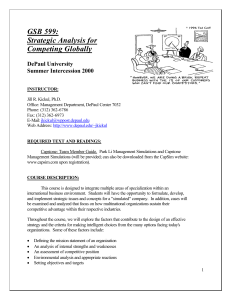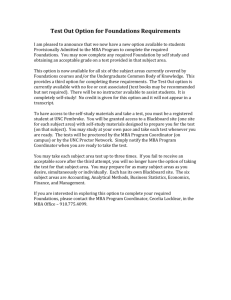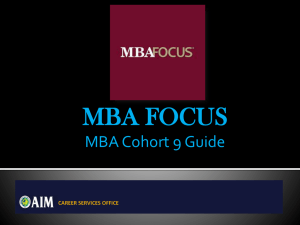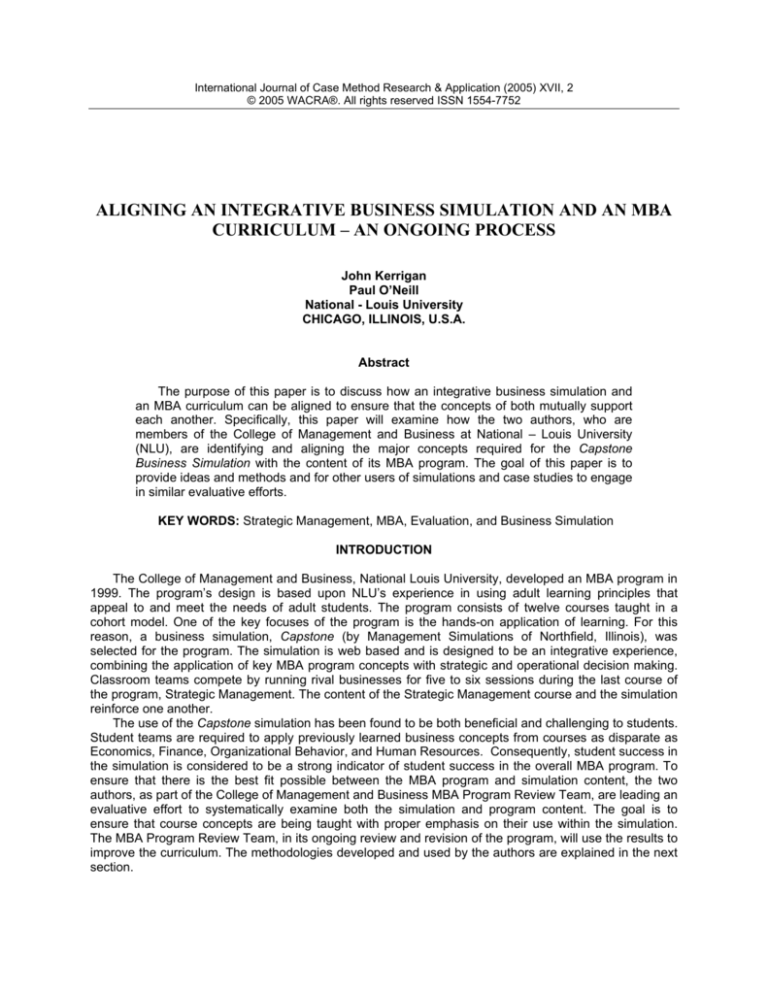
International Journal of Case Method Research & Application (2005) XVII, 2
© 2005 WACRA®. All rights reserved ISSN 1554-7752
ALIGNING AN INTEGRATIVE BUSINESS SIMULATION AND AN MBA
CURRICULUM – AN ONGOING PROCESS
John Kerrigan
Paul O’Neill
National - Louis University
CHICAGO, ILLINOIS, U.S.A.
Abstract
The purpose of this paper is to discuss how an integrative business simulation and
an MBA curriculum can be aligned to ensure that the concepts of both mutually support
each another. Specifically, this paper will examine how the two authors, who are
members of the College of Management and Business at National – Louis University
(NLU), are identifying and aligning the major concepts required for the Capstone
Business Simulation with the content of its MBA program. The goal of this paper is to
provide ideas and methods and for other users of simulations and case studies to engage
in similar evaluative efforts.
KEY WORDS: Strategic Management, MBA, Evaluation, and Business Simulation
INTRODUCTION
The College of Management and Business, National Louis University, developed an MBA program in
1999. The program’s design is based upon NLU’s experience in using adult learning principles that
appeal to and meet the needs of adult students. The program consists of twelve courses taught in a
cohort model. One of the key focuses of the program is the hands-on application of learning. For this
reason, a business simulation, Capstone (by Management Simulations of Northfield, Illinois), was
selected for the program. The simulation is web based and is designed to be an integrative experience,
combining the application of key MBA program concepts with strategic and operational decision making.
Classroom teams compete by running rival businesses for five to six sessions during the last course of
the program, Strategic Management. The content of the Strategic Management course and the simulation
reinforce one another.
The use of the Capstone simulation has been found to be both beneficial and challenging to students.
Student teams are required to apply previously learned business concepts from courses as disparate as
Economics, Finance, Organizational Behavior, and Human Resources. Consequently, student success in
the simulation is considered to be a strong indicator of student success in the overall MBA program. To
ensure that there is the best fit possible between the MBA program and simulation content, the two
authors, as part of the College of Management and Business MBA Program Review Team, are leading an
evaluative effort to systematically examine both the simulation and program content. The goal is to
ensure that course concepts are being taught with proper emphasis on their use within the simulation.
The MBA Program Review Team, in its ongoing review and revision of the program, will use the results to
improve the curriculum. The methodologies developed and used by the authors are explained in the next
section.
International Journal of Case Method Research & Application (2005) XVII, 2
205
RESEARCH STEPS AND METHODOLOGY
The ongoing evaluation of the MBA program has indicated that the Capstone simulation has been
beneficial in integrating MBA concepts. However, it was determined from student evaluations and
feedback from course instructors that there is an opportunity to better align the content of the MBA
courses with required simulation concepts. Working with this hypothesis, the following research steps and
procedures are being followed.
1. Identification of key concepts required for effective participation by students in the Capstone
simulation.
2. Development of an instrument (Capstone Concept Grid and MBA Courses) to determine where
those concepts are being taught in the MBA curriculum.
3. Development of an instrument (Capstone Simulation Concepts Student Evaluation) to be used by
students to evaluate the importance of the concepts and how well they are being taught.
4. Evaluation of results and the development of suggestions for improving the teaching of the
concepts in the MBA program.
IDENTIFICATION OF KEY CONCEPTS
A beginning point in identifying key concepts required of students for the simulation has been to
contact Management Simulations, the company that owns and services Capstone. The authors
interviewed one of the developers of the simulation, Dan Smith, who also has been an instructor for
several different groups. In response to the question of what concepts are required of students in order to
effectively engage in the simulation, Mr. Smith provided a listing of concepts that should be covered in
courses such as Managerial Accounting, Finance, Marketing, Microeconomics, and Operations.
DEVELOPMENT OF CONCEPT GRID FOR INSTRUCTORS
After developing an initial list of concepts from the above interview, the authors examined the
instructor and student support material for Capstone to identify additional required concepts. Other
instructors of the Strategic Management course and Capstone simulation were also consulted and their
input was added to the previously identified list of required concepts. A total of fifty-eight concepts were
identified. With the information from the above sources, a Capstone Concept Grid and MBA Courses was
created. A shortened version of this instrument is contained in Appendix A. A full list of concepts is
contained in Appendix B. The purpose of this Grid is to identify where in the MBA curriculum the concepts
are currently being taught and the amount of time spent on the concepts. The authors will review the
information from this Grid and compare it to the information obtained from the student evaluation process
described below. With the information from both sources, the authors will work with specific course
developers and instructors to determine where best in the program to cover required concepts. In
addition, suggestions will be developed as to how best to teach the concepts in order to maximize the
learning experience of the Capstone simulation.
DEVELOPMENT OF CONCEPT GRID FOR STUDENTS
Along with plans to obtain information from MBA program developers and instructors, the authors
want to obtain additional information from students on required Capstone concepts as they complete the
last course, Strategic Management, and the Capstone simulation. Students normally complete an
evaluation of the whole program and each of the courses. After examining the program and course
evaluations, the authors determined that a more specific instrument is needed to obtain information on
the identified required concepts. In designing an instrument, the authors needed to consider the large
number of concepts and the time needed by students to complete the instrument as well as the program
and course evaluation forms. For this reason the authors modified the previously mentioned Capstone
Concept Grid and MBA Courses into the Capstone Simulation Concepts Student Evaluation. The
instrument contains the fifty-eight required concepts and is designed to efficiently capture information
from students as to the importance of each Capstone concept, and how well each is being taught/covered
206
International Journal of Case Method Research & Application (2005) XVII, 2
in the MBA curriculum. Five point scales are used to evaluate each question. The data will be used to
identify the most important concepts that are in need of additional teaching support. The Capstone
Simulation Concepts Student Evaluation is contained in Appendix B.
The results of the Capstone Simulation Concepts Student Evaluation will be compared to the
information from the Capstone Concept Grid and MBA Courses to determine if there are required
concepts that are high in importance, not well covered in the MBA curriculum, with insufficient or no
instructional time being provided by instructors. This information will be summarized and shared initially
with the MBA Program Review Team and with the course authors. The results will be used to modify
course design and instruction. Subsequent student evaluations of the simulation will be used to determine
the degree of improvement in student preparation for the simulation. The ongoing evaluations will also
serve as a means of continuing feedback to course instructors and will serve as an important base for
continuous improvement of the MBA program.
EXAMINATION OF INITIAL RESULTS AND SUGGESTIONS
As of this writing, a Capstone Concept Grid and MBA Courses has been completed by course
instructors/authors for each of the MBA’s thirteen courses. In addition, twenty-three students in two MBA
groups have completed the Capstone Simulation Concepts Student Evaluation. Additional evaluations will
be added to the data pool as students complete the simulation.
Our initial analysis of the evaluations indicated that the majority of concepts required for effective
participation are being effectively covered in the MBA courses. We next determined that the greatest
opportunity for improvement would be to identify concepts that were rated high in importance (“extremely
important” or “very important”), and rated as inadequately covered in the curriculum (“somewhat” or “not
at all”). These identified concepts were then compared to time spent on them by course
authors/instructors. As a result, a group of concepts have been highlighted as needing more emphasis
within several courses. These concepts, the percentage of students rating each as high importance yet
low coverage, and our initial suggestions for improvement are listed below.
1. “Automation” and “Automation Versus Labor Costs” (both rated high importance/low coverage by
26% of students).
Automation is covered briefly in the Human Resources Management course (20 minutes) and in
the Operations course (20 minutes). The automation module from Capstone could be used in
either course to develop examples that would better explain the financial and human resource
implications of automation.
2. “Product Reliability – MTBF” (rated high importance/low coverage by 26% of students)
The Operations course spends 20 minutes on this concept. More time needs to devoted to this
concept, perhaps by using an example from Capstone in the Operations course.
3. “Improving Productivity through Human Resource Development and Selection” (rated high
importance/low coverage by 17% of students).
The Human Resources Management course spends 45 minutes on this concept. Course
instructors should examine the HR module in Capstone and develop examples on the cost and
productivity gains from training, selection, and planned staffing. These examples could also be
linked to the automation concept and examples.
4. “Maximizing Plant Utilization” and “Capacity Analysis” (rated high importance/low coverage by
17% of students).
The Operations course spends at least an hour on these two concepts. Again, instructors should
refocus the concept through specific examples from the Capstone simulation.
5. “Customer Satisfaction Report”; “Product Determination Decision”; “Perceptual Map”; “Number of
Products in Segment Product”; and “Product Age” (all rated high importance/low coverage by
13% of students).
None of these concepts are covered in the detail necessary to effectively participate in the
Capstone simulation. Instructors should develop specific examples and include these in the
Strategic Marketing course.
International Journal of Case Method Research & Application (2005) XVII, 2
207
ANTICIPATED IMPROVEMENTS IN THE MBA PROGRAM
As a result of this ongoing evaluation and feedback, the following improvements are expected to be
made in the MBA Program generally, and the Capstone simulation specifically:
1. The MBA curriculum will be more complete.
2. The MBA curriculum will be more cohesive.
3. Students will be better prepared for the simulation.
4. Students will be better able to use the case study to integrate the MBA course concepts.
5. Students will be better able to transfer the learnings derived from the simulation to their own
organizations.
CONCLUSION
This paper has demonstrated that simulations can do far more than aid in the teaching of specific
course content. Not only can they be used to integrate several disciplines, but they can also be effectively
used as a form of ongoing evaluation to ensure that individual courses, as well as an entire curriculum,
are being well presented to students. The authors hope that the methodology and instruments used in
this evaluation will inspire other course developers and instructors to evaluate and integrate simulations
and program materials.
208
International Journal of Case Method Research & Application (2005) XVII, 2
APPENDIX A:
Name of Course Reviewer
Name and Number of Course Reviewed:
CAPSTONE CONCEPT GRID AND MBA COURSES
Please indicate the amount of time you spend on any of the following
concepts in the course you have been asked to review.
The possible time amounts are listed below
Please indicate the number that correspond to the appropriate time spent
(For example if you spent 24 minutes on a concept, you would place a 1. in the appropriate cell.
If you would spend 34 minutes you would place a 2. in the appropriate cell)
1. 10 to 30 minutes
2. 31 minutes to 60 minutes
3. 61 minutes or more
International Journal of Case Method Research & Application (2005) XVII, 2
Concept/Course
MBA
Financial Statements
(BS, Income Stmt)
Working Capital
Loans and debt
management
Financial Ratios
Corporate strategy on
wealth distribution
Capital Acquisition
Dividend Policy
Credit Practices
Financial Structure –
Debt/Equity
Cash Flow
Four P’s of Marketing
Marketing
Segmentation
Forecasting
Supply, demand, and
price
Product distinction
Price, size, reliability,
positioning, age
Customer purchasing
decision
Intro
OB
HRM
Ethics
500
502
504
506
Mgr. Macro
Econ
508
510
209
Intl
512
Mgr
Acct
514
Fin.
Mkts
516
Fin.
Mgt.
518
Ops
Mgt
520
Strategic Strategic
Market
Mgt
522
524
210
International Journal of Case Method Research & Application (2005) XVII, 2
APPENDIX B:
CAPSTONE SIMULATION CONCEPTS
EVALUATION
Contained below are major concepts that have been identified as important for effectively engaging in the Capstone Business
Simulation. Would you please indicate the importance of each of these concepts and how well the concepts have been covered in
the MBA program. Please do so by placing checks in the appropriate boxes for each concept. The information that you and other
students provide will be used for future improvements in the program.
IMPORTANCE
Concept/Course
Financial Statements
(BS, Income Stmt)
Working Capital
Loans and debt
management
Financial Ratios
Corporate strategy on
wealth distribution
Capital Acquisition
Dividend Policy
Credit Practices
Financial Structure –
Debt/Equity
HOW WELL COVERED IN PROGRAM
Extremely
Very
Aver.
5
4
3
Somewhat
2
Not
Import
1
Extremely
Very
Avg.
5
4
3
Somewhat.
2
Not
Import
1
International Journal of Case Method Research & Application (2005) XVII, 2
Concept/Course
Cash Flow
Four P’s of Marketing
Marketing
Segmentation
Forecasting
Supply, demand, and
price
Product distinction
Price, size, reliability,
positioning, age
Customer purchasing
decision
Consumer
Satisfaction Report
Margin Analysis
Breakeven Analysis
Capacity Analysis &
Utilization
Inventory Costs
Fixed costs
Maximizing plant
utilization
Labor Costs
Automation
Extremely
Very
Aver.
5
4
3
Somewhat
2
211
Not
Import
1
Extremely
Very
Avg.
5
4
3
Somewhat.
2
Not
Import
1
212
Concept/Course
Product Termination
Decision
Perceptual Map
# Products in
Segment
Product Age
Product Reliability
MTBF
Cost of Material
New Facilities
Automation vrs labor
Cost
Types of R&D
Projects
(repositioning,
inventing, & reliability
adjustment)
Material Costs
Project management
Cycle Completion
Times
Improving Productivity
Through HR
Development &
Selection
International Journal of Case Method Research & Application (2005) XVII, 2
Extremely
Very
Aver.
5
4
3
Somewhat
2
Not
Import
1
Extremely
Very
Avg.
5
4
3
Somewhat.
2
Not
Import
1
International Journal of Case Method Research & Application (2005) XVII, 2
Concept/Course
Needed Complement
of workers
HR Impact: Costs and
Savings due to
Automation
Staffing Costs:
Recruiting & Training
Budget
Factors Impacting
Employee Turnover
Labor Negotiations
TQM
Process Management
Industry Analysis
Competitor Analysis
Industry Capacity
Analysis
Corporate Strategies
Business Strategies
Strategy/Functional
Area Alignment
Market Positioning
Extremely
Very
Aver.
5
4
3
Somewhat
2
213
Not
Import
1
Extremely
Very
Avg.
5
4
3
Somewhat.
2
Not
Import
1
214
Concept/Course
International Journal of Case Method Research & Application (2005) XVII, 2
Extremely
Very
Aver.
5
4
3
Somewhat
2
Not
Import
1
Organizational
Planning&
Communication
Mission/Vision
Formation
SWOT Analysis
Business Success
Indicators
Completed Capstone Simulation Concepts Evaluations should be sent to:
Extremely
Very
Avg.
5
4
3
Somewhat.
2
Not
Import
1



